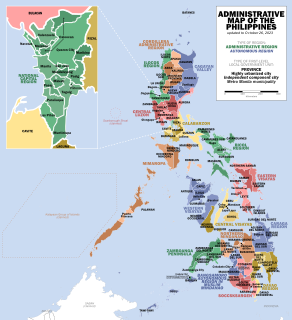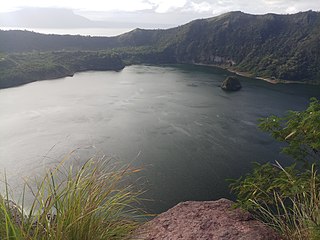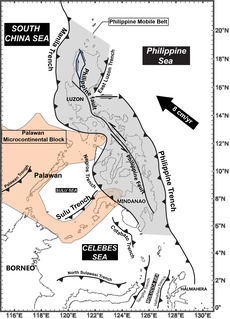The topic of this article may not meet Wikipedia's notability guideline for stand-alone lists .(October 2020) |
The list of well-known geologic formations in the Philippines. [1]
The topic of this article may not meet Wikipedia's notability guideline for stand-alone lists .(October 2020) |
The list of well-known geologic formations in the Philippines. [1]

The Philippines is an archipelago that comprises 7,641 islands with a total land area of 300,000 square kilometers (115,831 sq mi). It is the world's fifth largest island country. The eleven largest islands contain 95% of the total land area. The largest of these islands is Luzon at about 105,000 square kilometers (40,541 sq mi). The next largest island is Mindanao at about 95,000 square kilometers (36,680 sq mi). The archipelago is around 800 kilometers (500 mi) from the Asian mainland and is located between Taiwan and Borneo.

Luzon is the largest and most populous island in the Philippines. It is ranked 15th largest in the world by land area. Located in the northern portion of the archipelago, it is the economic and political center of the nation, being home to the country's capital city, Manila, as well as Quezon City, the country's most populous city. With a population of 53 million as of 2015, it contains 52.5% of the country's total population and is the fourth most populous island in the world.

The Visayas, or the Visayan Islands, are one of the three principal geographical divisions of the Philippines, along with Luzon and Mindanao. Located in the central part of the archipelago, it consists of several islands, primarily surrounding the Visayan Sea, although the Visayas are also considered the northeast extremity of the entire Sulu Sea. Its inhabitants are predominantly the Visayan peoples.

In the Philippines, regions are administrative divisions that primarily serve to coordinate planning and organize national government services across multiple local government units (LGUs). Most national government offices provide services through their regional branches instead of having direct provincial or city offices. Regional offices are usually but not necessarily located in the city designated as the regional center.
The Philippine archipelago is one of the world's great reservoirs of biodiversity and endemism. The archipelago includes over 7000 islands, and a total land area of 300,780 km².
The Central Philippine languages are the most geographically widespread demonstrated group of languages in the Philippines, being spoken in southern Luzon, Visayas, Mindanao, and Sulu. They are also the most populous, including Tagalog, Bikol, and the major Visayan languages Cebuano, Hiligaynon, Waray, Kinaray-a, and Tausug, with some forty languages all together.

Platymantis is a genus of frogs in the family Ceratobatrachidae. They are commonly known as wrinkled ground frogs, ground frogs, and forest frogs.

The Philippine warty pig is one of four known species in the pig genus (Sus) endemic to the Philippines. The other three endemic species are the Visayan warty pig, Mindoro warty pig and the Palawan bearded pig, also being rare members of the family Suidae. Philippine warty pigs have two pairs of warts, with a tuft of hair extending outwards from the warts closest to the jaw. It has multiple native common names, but it is most widely known as baboy damo in Tagalog.

The Christian And Missionary Alliance Churches of the Philippines (CAMACOP) is a Christian evangelical group in the Philippines that originated from The Christian and Missionary Alliance (C&MA). It is one of the largest evangelical groups in the Philippines.

The following outline is provided as an overview of and topical guide to the Philippines:

The Philippine Mobile Belt is a complex portion of the tectonic boundary between the Eurasian Plate and the Philippine Sea Plate, comprising most of the country of the Philippines. It includes two subduction zones, the Manila Trench to the west and the Philippine Trench to the east, as well as the Philippine Fault System. Within the Belt, a number of crustal blocks or microplates which have been shorn off the adjoining major plates are undergoing massive deformation.
The Philippine Fault System is a major inter-related system of geological faults throughout the whole of the Philippine Archipelago, primarily caused by tectonic forces compressing the Philippines into what geophysicists call the Philippine Mobile Belt. Some notable Philippine faults include the Guinayangan, Masbate and Leyte faults.

The Luzon rain forests is a tropical moist broadleaf forest ecoregion on the island of Luzon. Luzon is the largest island in the Philippines, and the Luzon rain forests is the most extensive rainforest ecoregion of the country. The ecoregion includes the lowlands of Luzon and neighboring islands below 1000 meters elevation. Very little of the original rainforest remains, and the status of this area is critical/endangered.
The 2013 PFF National Men's Club Championship was the 3rd season of the PFF National Men's Club Championship, a Filipino association football competition organized by the Philippine Football Federation.
Biosphere reserves are areas comprising terrestrial, marine and coastal ecosystems. The biosphere reserve title is handed over by UNESCO. Each reserve promotes solutions reconciling the conservation of biodiversity with its sustainable use. Biosphere reserves are 'Science for Sustainability support sites' – special places for testing interdisciplinary approaches to understanding and managing changes and interactions between social and ecological systems, including conflict prevention and management of biodiversity. Biosphere reserves are nominated by national governments and remain under the sovereign jurisdiction of the states where they are located. Their status is internationally recognized.

The subduction tectonics of the Philippines is the control of geology over the Philippine archipelago. The Philippine region is seismically active and has been progressively constructed by plates converging towards each other in multiple directions. The region is bounded by subduction zones, where surrounding oceanic plates to the east and west slide towards the centre of the Philippine archipelago. Subduction results in deep oceanic trenches, such as the Philippine Trench and Manila Trench, bounding the eastern and western sides of the Philippine archipelago, respectively. The Philippine archipelago is also cut along its length by a left-lateral strike-slip fault known as the Philippine Fault. The region is also known as the Philippine mobile belt due to its complex tectonic setting.
Philippine ceramics are mostly earthenware, pottery that has not been fired to the point of vitrification. Other types of pottery like tradeware and stoneware have been fired at high enough temperatures to vitrify. Earthenware Ceramics in the Philippines are mainly differentiated from Tradeware and stonewares by the materials used during the process and the temperature at which they are fired. Additionally, earthenware and stoneware pottery can generally be referred to as ceramics that are made with local materials, while tradeware ceramics can generally be referred to as ceramics that are made with non-local materials.

The Luzon montane rain forests is a tropical moist broadleaf forest ecoregion on the island of Luzon in the Philippines. The ecoregion is located on several volcanic and non-volcanic mountains of the island. Luzon is the largest and northernmost major island of the Philippines, located in the western Pacific Ocean.